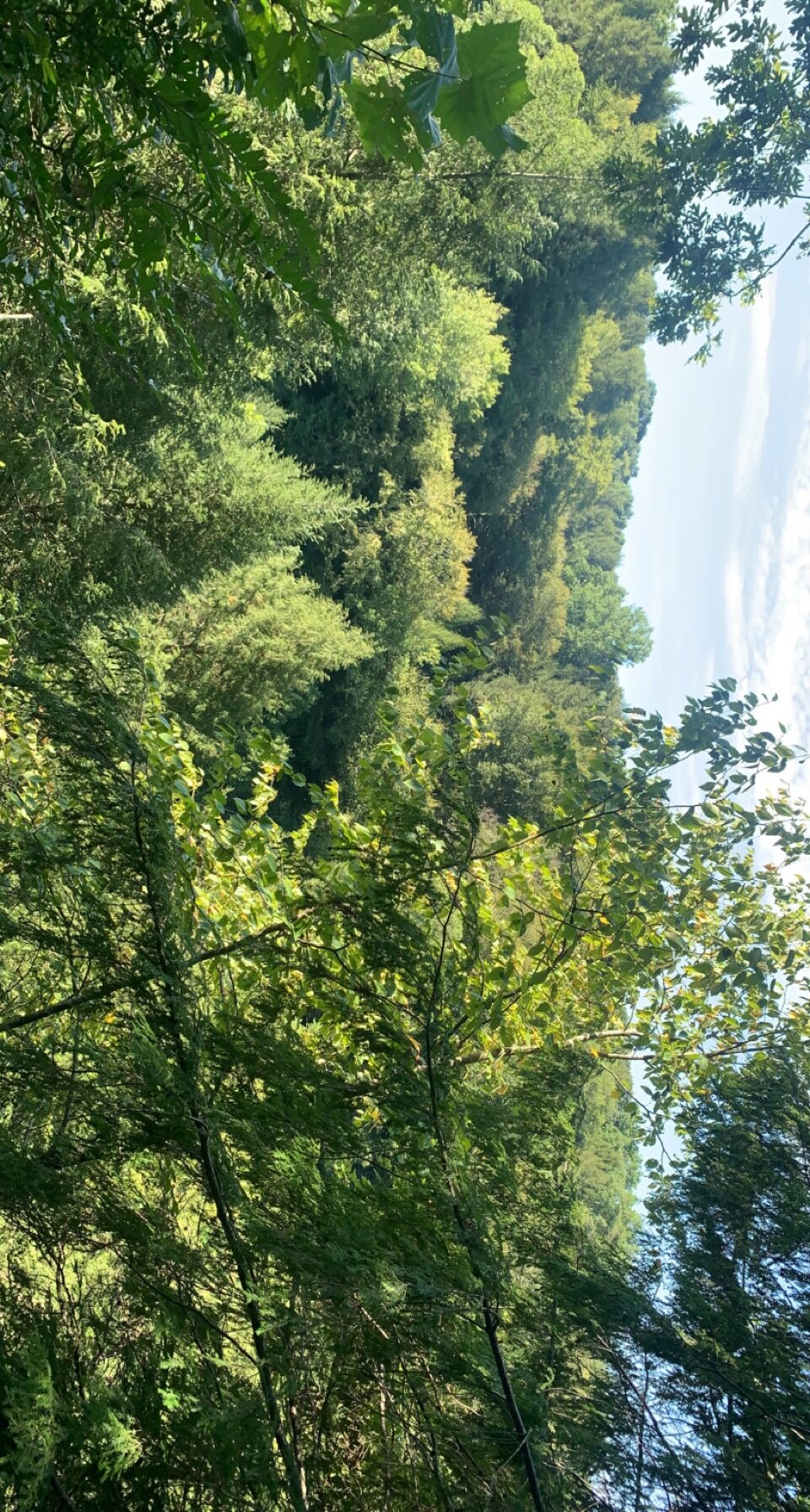Species List with CC Values and Floristic Quality Assessment Index (FQAI)
# Common name Scientific name CC value
| 1 | Black locust (native) | Robinia pseudoacacia | 0 |
| 2 | Annual ragweed (native) | Ambrosia artemisiifolia | 0 |
| 3 | Poison ivy (native) | Toxicodendron radicans | 1 |
| 4 | Canada goldenrod (native) | Solidago canadensis | 1 |
| 5 | Hedge bindweed (native) | Calystegia sepium | 1 |
| 6 | Common blackberry (native) | Rubus allegheniensis | 1 |
| 7 | American pokeweed (native) | Phytolacca americana | 1 |
| 8 | New england aster (native) | Symphyotrichum novae-angliae | 2 |
| 9 | American elm (native) | Ulmus americana | 2 |
| 10 | White snakeroot (native) | Ageratina altissima | 3 |
| 11 | Black cherry (native) | Prunus serotina | 3 |
| 12 | Box elder (native) | Acer negundo | 3 |
| 13 | Yellow jewelweed (native) | Impatiens pallida | 3 |
| 14 | Slippery elm (native) | Ulmus rubra | 3 |
| 15 | Roughleaf dogwood (native) | Cornus drummondii | 3 |
| 16 | Sawtooth sunflower (native) | Helianthus grosseserratus | 4 |
| 17 | Common hackberry (native) | Celtis occidentalis | 4 |
| 18 | Sneezeweed (native) | Helenium autumnale | 4 |
| 19 | Honey locust (native) | Gleditsia triacanthos | 4 |
| 20 | American hophornbeam (native) | Ostrya virginiana | 5 |
| 21 | Wingstem (native) | Verbesina alternifolia | 5 |
| 22 | Bitternut hickory (native) | Carya cordiformis | 5 |
| 23 | Pin oak (native) | Quercus palustris | 5 |
| 24 | Black walnut (native) | Juglans nigra | 5 |
| 25 | White ash (native) | Fraxinus americana | 6 |
| 26 | Smooth blue aster (native) | Symphyotrichum laeve | 7 |
Floristic Quality Assessment Index:
The FQAI is calculated by summing the C of C values for all species identified within a specific survey area and dividing by the square root of the total number of species
Sum of CC values= 81
sqrt(26)= 5.099
81/(5.099)= 15.885
FQAI= 15.885
Four of the Highest CC Values
Smooth blue aster (native): Symphyotrichum laeve, CC value= 7
Smooth blue aster is about one inch across with 15 to 30 ray flowers and yellow center disc flowers that turn reddish when older, the ray flowers are usually a light to medium blue or purple, rarely white (the smooth blue aster found at my site is white). Deer and rabbits are strong fans of smooth blue aster, along with bees and butterflies. Smooth blue aster can get different fungus diseases such as powdery mildew, there are fungicides available to cure this, but it is better to avoid this to begin with by allowing spacing and direct sunlight.
Smooth blue aster (Symphyotrichum laeve) has a high CC because it is considered as a plant with a narrow range of ecological tolerances that typify a stable or near “climax” community. Smooth blue aster is also considered a species that is found in high-quality remnant plant communities but appear to endure some disturbance at times. Therefore. smooth blue asters are commonly found in different environments and can usually endure changes and is able to reproduce under multiple conditions.
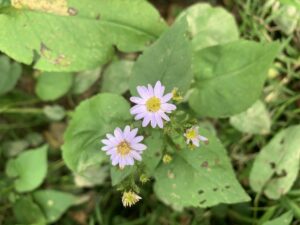
Smooth blue aster (native): Symphyotrichum laeve, CC value= 7
White ash (native): Fraxinus americana, CC value= 6
White ash has opposite pinnately compound leaves with five to nine leaflets. It can be told about from the other ashes by looking at the leaf scar and if it is a “smiley” scar with the bud wedged in the scar then it is a white ash, compared to a green ash where the bud would sit on top. Currently it is not suggested to plant new ash trees due to the emerald ash borer which seems to be knocking out the population. The emerald ash borer is an invasive pest which will bore into the wood and feed under the bark. There is still research being done to find a natural predator to the borer to help the ash trees survive for longer.
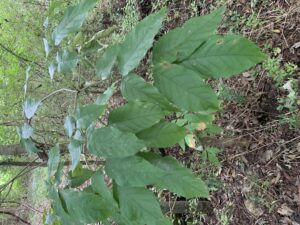
White ash (native): Fraxinus americana, CC value= 6
Black walnut (native): Juglans nigra, CC value= 5
Black walnut has alternate pinnately compound leaves, ranging from 10-23 leaflets with the terminal leaflet often missing or reduced. Black walnuts have a true terminal bud and a chambered pith. The fruits of walnuts are large drupes, which are single-seeded with a bony endocarp and a fleshy exocarp surrounding it. Black walnut is an allelopathic plant, which means it makes its neighbors sick. Black walnut’s roots, leaves, and fruits produce a chemical called juglone which inhibits the growth of some plants, especially those in the tomato family. Allelopathy minimizes competition from other plants.
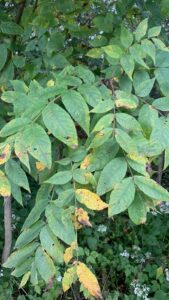
Black walnut (native): Juglans nigra, CC value= 5
Pin oak (native): Quercus palustris, CC value= 5
Pin oak, or oaks in general, have alternate and simple leaves. It is a member of the red oak ground and has deeply lobed leaves with bristled tips, and acorns that mature in two years. Pin oak is very site sensitive and prefers moist, acidic sites. When pin oak is found on sites that are not acidic, it often can be seen having iron chlorosis, which is yellowing of the leaf tissue between the veins, which is due to iron deficiency because of low availability of iron in higher pH soils.
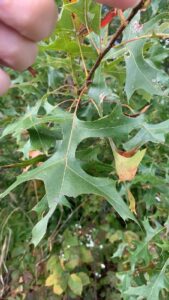
Pin oak (native): Quercus palustris, CC value= 5
Four of the Lowest CC Values
Annual ragweed (native): Ambrosia artemisiifolia, CC value= 0
Annual ragweed grows up to three feet tall, branches frequently, the hairy stems are green to light pinkish red, the leaves are six inches long and four inches across and can be opposite or alternate along the stems. It is also deeply pinnatifid. Annual ragweed can be a major cause of hay fever during the late summer and early autumn, but has ecological value for some birds, moths, and other insects.
Annual ragweed is a native plant with a CC of 0. This means that it has a wide range of ecological tolerances. It is also most likely an opportunistic invader of natural areas. This species shows little connection with remnant natural habitats and will opportunistically occupy disturbed areas.
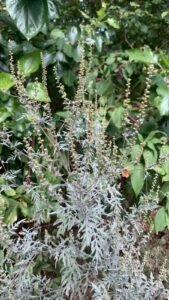
Annual ragweed (native): Ambrosia artemisiifolia, CC value= 0
Black locust (native): Robinia pseudoacacia, CC value= 0
Black locust leaves are opposite and composite with each leaf containing 7-19 leaflets. The leaves have an odd number, with a single leaflet at the end of each leaf. The leaves are a blue-green color. Black locust was brought to western United States by gold miners who would grow the plant for mining timbers. It was once planted in California because the wood made great railroad timbers. The plant was also introduced to France, and the wood was used for shipbuilding, the flowers were used in cooking, and the fruit was used as a coffee substitute.
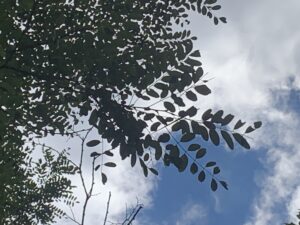
Black locust (native): Robinia pseudoacacia, CC value= 0
Poison ivy (native): Toxicodendron radicans, CC value= 1
Poison ivy usually grows as a woody vine that climbs trees or in the ground and can appear shrubby. It has alternate and trifoliate leaves. When it grows on trees it produces aerial rootlets that attaches to the tree. It produces fruits that are drupes. Poison ivy has often been confused with or been talked about with poison oak and poison sumac, but there are differences between the three. Poison oak is not found in Ohio, it is poison ivy-like in appearance, but is often seen shrubby and has distinctly lobed leaves. Poison sumac is different in appearance, it is a shrub or small tree with pinnately compound leaves, and it is a specialist that is only found in high-quality wetlands called “mires”, bogs and fens. Lastly, poison ivy is very widespread and abundant.
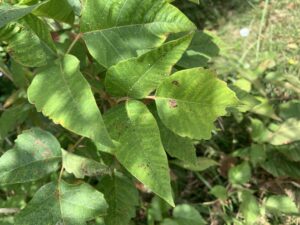
Poison ivy (native): Toxicodendron radicans, CC value= 1
Canada goldenrod (native): Solidago canadensis, CC value= 1
Canada goldenrod has a central stem which is clad with numerous, narrow, alternate, lance-shaped, sharply toothed, stalkless to short-stalked green leaves which are hairless above but hairy beneath and tapered at each end. The central stem can grow to be about five feet, and sometimes up to seven feet, and in late summer to fall, it has large horizontally branches terminal pyramidal panicles containing one-sided recurving branches filled with masses of tiny yellow flowers. Canada goldenrod is susceptible to rust, powdery mildew, and leaf spot. The plant can also be affected by root rot in poorly drained soil.
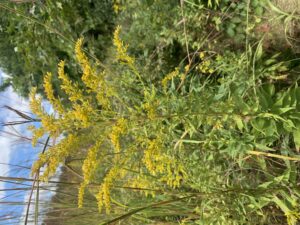
Canada goldenrod (native): Solidago canadensis, CC value= 1
Four Invasive Species
Amur honeysuckle (Lonicera maackii)
Amur honeysuckle is an upright deciduous shrub that can be up to 20 feet. The leaves are opposite and ovate with a tapered tip. The flowers are paired, tubular, white to pinkish and fade to yellow, and less than one inch long. The fruits are red or orange-red which are produced in late summer and persist through winter. This invasive spreads through the fruits which are spread by birds. Amur honeysuckle was originally introduced in New York in 1898, and was used for wildlife cover and soil erosion control, but it has escaped from plantings and reproduced on its own and spread into natural areas.
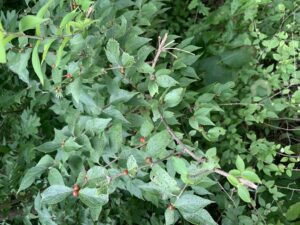
Amur honeysuckle (Lonicera maackii)
Autumn olive (Elaeagnus umbellata)
Autumn olive has grayish green leaves with silvery scales bottom side. The stems are speckled, often with thorns, the flowers are bell-shaped flower clusters which are cream or yellow colored, and the fruit are silvery that ripens to red. Autumn olive was actually introduced on purpose and its original purpose was to provide erosion control near roads and on ridges, and provide wildlife habitat, but it is now an invasive and a major hassle by outcompeting and displacing native plants.
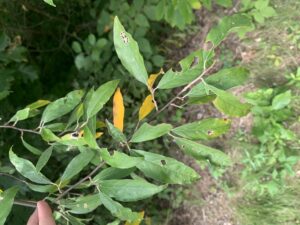
Autumn olive (Elaeagnus umbellata)
Multiflora rose (Rosa multiflora)
Multiflora rose has pinnately compound leaves which are alternately arranged and have prominent feathery stipules at the base. They also contain prickles. The flower have many stamens, spirally arranged, the pollen-receptive stigmas are packed together, and the flowers are smaller than native rose flowers. The fruits are small hips displayed in panicles. Along with amur honeysuckle and autumn olive, multiflora rose is also an invasive shrub found in Ohio.
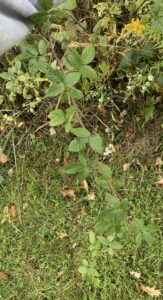
Multiflora rose (Rosa multiflora)
Wintercreeper (Euonymus fortunei)
Wintercreeper is a perennial evergreen vine that runs along the ground, or climbing trees and shrubs (as seen below). The leaves are opposite, oval, dark green, and glossy that are less than an inch long. The leaves also often have a distinct silvery-white vein. The fruits are smooth and pinkish-orange that mature in the fall. Wintercreeper was originally introduced on purpose as an ornamental ground cover plant, but can spread from planting into natural areas and undisturbed woodlands and forests. It grows rapidly, even under harsh conditions. It is found in a variety of habitats, can tolerate full sun, heavy shade, and moist soil conditions.
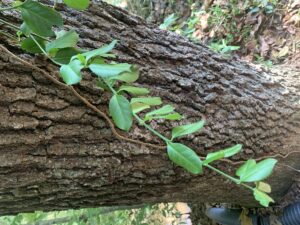
Wintercreeper (Euonymus fortunei)
Four Substrate-Associated Species
Limestone or high-lime substrates:
Hackberry (Celtis occidentalis)
Hackberry is a tree with alternate simple with once-serrate leaves that are ovate with long tips and bases that are oblique. The flowers are unisexual and are produced in drooping clusters borne in the axils of leaves. The fruits are pea-sized purple-black drupes with a thin sweet exocarp that covers a relatively large pit. The bark of hackberry is corky-ridged. The leaves of hackberry often have leaf galls that are caused by a type of fly called a midge. The substrate that hackberry is associated with is limestone or high-lime substrates. Based on the observations made at my botanical site, I do concur, there are many limestone or high-lime substrates in that area. Limey areas is very common at my site.
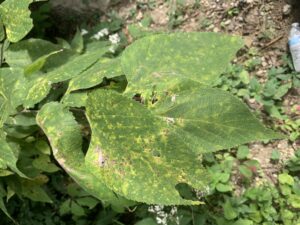
Hackberry (Celtis occidentalis)
hophornbeam (Ostrya virginiana)
Hophornbeam has leaves that are alternate in arrangement, simple in complexity, and have sharply serrate margins. The leaves are also ovate and the veins are straight. The bark is rough and scaly that split into vertical plates. It is called hophornbeam because the fruits look like hops, which is the beer flavoring plant. The substrate that hophornbeam is associated with is limestone or high-lime substrates. Based on the observations made at my botanical site, I do concur, there are many limestone or high-lime substrates in that area. Limey areas is very common at my site.
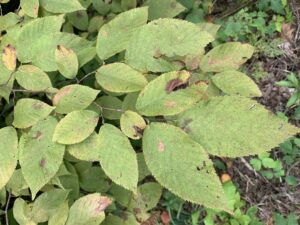
Hophornbeam (Ostrya virginiana)
The high-lime, clay-rich thick till plains:
Pin oak (Quercus palustris)
Pin oak, or oaks in general, have alternate and simple leaves. It is a member of the red oak ground and has deeply lobed leaves with bristled tips, and acorns that mature in two years. Pin oak is very site sensitive and prefers moist, acidic sites. When pin oak is found on sites that are not acidic, it often can be seen having iron chlorosis, which is yellowing of the leaf tissue between the veins, which is due to iron deficiency because of low availability of iron in higher pH soils. The substrate that pin oak is associated with is high-lime, clay-rich thick till plains. Based on the observations made at my botanical site, I do concur, there are many high-lime plants in the area and the soil does seem to be high in clay. Limey areas is very common at my site.

Pin oak (Quercus palustris)
White ash (Fraxinus americana)
White ash has opposite pinnately compound leaves with five to nine leaflets. It can be told about from the other ashes by looking at the leaf scar and if it is a “smiley” scar with the bud wedged in the scar then it is a white ash, compared to a green ash where the bud would sit on top. Currently it is not suggested to plant new ash trees due to the emerald ash borer which seems to be knocking out the population. The emerald ash borer is an invasive pest which will bore into the wood and feed under the bark. There is still research being done to find a natural predator to the borer to help the ash trees survive for longer. The substrate that white ash is associated with is high-lime, clay-rich thick till plains. Based on the observations made at my botanical site, I do concur, there are many high-lime plants in the area and the soil does seem to be high in clay. Limey areas is very common at my site.

White ash (Fraxinus americana)
